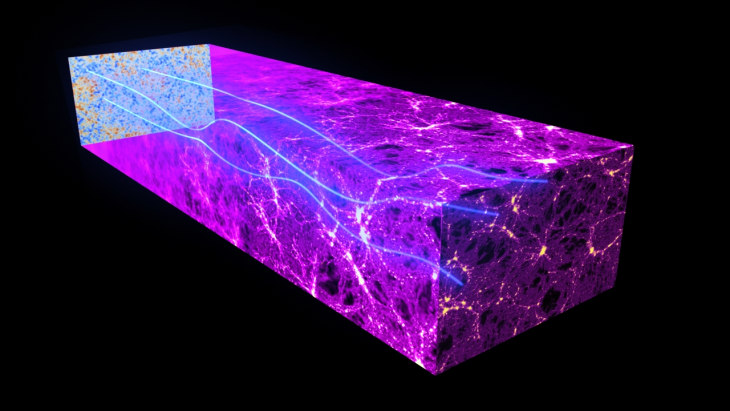Welcome to DU!
The truly grassroots left-of-center political community where regular people, not algorithms, drive the discussions and set the standards.
Join the community:
Create a free account
Support DU (and get rid of ads!):
Become a Star Member
Latest Breaking News
General Discussion
The DU Lounge
All Forums
Issue Forums
Culture Forums
Alliance Forums
Region Forums
Support Forums
Help & Search
Science
Related: About this forumScientists Discover A New Twist In Light From The Early Universe - Space.com/MSNBC
Scientists discover a new twist in light from the early universeMegan Gannon - Space.com/MSNBC
Oct. 18, 2013 at 8:42 PM ET

This artist’s impression shows how photons in the cosmic microwave background (as detected by the Planck space telescope) are deflected by the gravitational lensing effect of massive cosmic structures as they travel across the universe. (ESA / Planck Collaboration)
<snip>
Researchers have discovered a subtle twist in the primeval light that formed shortly after the universe came into being. They hope it can reveal new secrets about the moments after the big bang.
This afterglow, called Cosmic Microwave Background, or CMB, was created out of hot ionized plasma some 13.7 billion years ago, when the universe was just 380,000 years old. A small fraction of this light is polarized,meaning the light waves vibrate in one plane.
Researchers had already detected this polarized light in one pattern, known as "electric" or E-mode polarization. But using the South Pole Telescope in Antarctica and the European Space Agency's Herschel space observatory, researchers for the first time detected polarized light from the cosmic microwave background in the "magnetic" or B-mode.
The observed B-mode pattern arose from gravitational lensing, in which light gets bent and deflected by massive cosmic objects such as galaxy clusters and lumps of mysterious dark matter, researchers said. But there is another way to produce B-modes: primordial gravitational waves produced during the earliest moments of the universe, when it was in its rapid "inflation" phase, mere trillionths of a second after the big bang.
During inflation, the idea goes, the universe expanded faster than the speed of light, doubling in size 100 times or more in just a few tiny fractions of a second. (Einstein's theory of special relativity holds that no information or matter can travel faster than light through space, but this rule does not apply to inflation, which was an expansion of space itself.)
The new detection should provide a baseline to aid future...
<snip>
More: http://www.nbcnews.com/science/scientists-discover-new-twist-light-early-universe-8C11422949
InfoView thread info, including edit history
TrashPut this thread in your Trash Can (My DU » Trash Can)
BookmarkAdd this thread to your Bookmarks (My DU » Bookmarks)
2 replies, 2676 views
ShareGet links to this post and/or share on social media
AlertAlert this post for a rule violation
PowersThere are no powers you can use on this post
EditCannot edit other people's posts
ReplyReply to this post
EditCannot edit other people's posts
Rec (22)
ReplyReply to this post
2 replies
 = new reply since forum marked as read
Highlight:
NoneDon't highlight anything
5 newestHighlight 5 most recent replies
= new reply since forum marked as read
Highlight:
NoneDon't highlight anything
5 newestHighlight 5 most recent replies
Scientists Discover A New Twist In Light From The Early Universe - Space.com/MSNBC (Original Post)
WillyT
Oct 2013
OP
ffr
(22,665 posts)1. Wild concepts to absorb, but I LOVE IT!
How did Einstein do all this stuff without a super-computer?
longship
(40,416 posts)2. With gedankenexperiment!
Einstein came up with the technique of gedankenexperiment which enabled him to break through the paradigms of the current physics (to use a Kuhnian term) and weave a new universe.
The test of the paradigm, however, proceeded by way of actual physical experiments, in other words, by way of normal scientific principles.